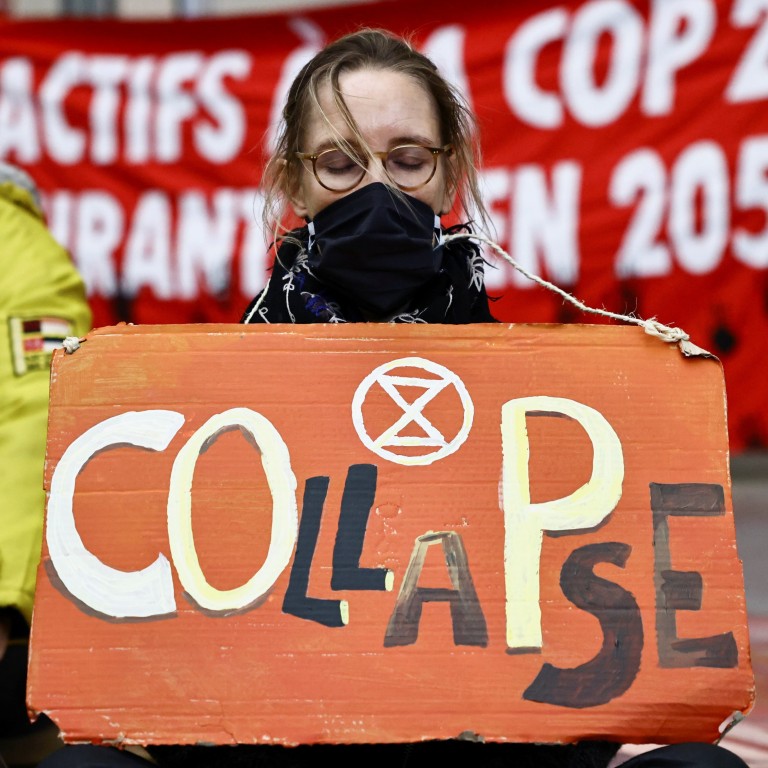
COP26: talk of US$130 trillion is cheap when a global carbon fund is the need of the hour
- How could the world’s rich economies, after failing for 12 years to provide US$100 billion a year in climate finance, suddenly be talking about US$130 trillion?
- The best progress will be made not with headline-grabbers, but by more focused initiatives like agreement on carbon trading and a simple carbon fund
But under-delivery was perhaps inevitable since COP26 is a body designed for high-level discussion rather than concrete delivery. Getting to net zero is a matter of a trillion tiny steps that world leaders are ill equipped to get into the nitty-gritty of.
Even so, many campaigners gathered in Glasgow this week will complain that this recognition has taken too long to crystallise, and may already be too late.
Even before claims of “greenwashing” welled up – along with talk of double counting, and the realisation that US$130 trillion was not funds ready for investment, but the total assets managed by the 450 institutions – the claim was implausible.
How could the world’s rich economies, after failing for 12 years to deliver on a promise to provide US$100 billion a year in climate finance to poor economies, suddenly be talking about US$130 trillion? Remember, US$130 trillion is equivalent to 40 per cent of the world’s financial assets, six times larger than the United States economy, and larger than the aggregate capitalisation of the world’s stock markets.

Carney is undoubtedly acting in good faith to ensure the world’s financial sector contributes meaningfully to the green transition of the next three decades. But his willingness to grab headlines has damaged the credibility of the Gfanz initiative. As the Financial Times’ Lex column noted, Carney’s “expansive use of statistics is unwise”.
It is exactly initiatives like this that prompt Thunberg to dismiss the business community’s “blah, blah, blah”. It prompts the Rainforest Action Group to point out that 93 of the Gfanz signatories provided US$575 billion to the fossil fuel industry in 2020.
Carney’s bullet in the foot is sad and important, because it muddies the reality that a large part of the world’s financial services industry is moving fast to assist the green shift, and because Carney is right that we cannot get to net zero without a prodigious commitment of financial resources.
A carbon-neutral Northern Metropolis. Now that’s a plan worth executing
A carbon fund attracts less attention, but could be valuable in providing an objective and transparent way of getting big emitters to cut emissions, and in helping low-income countries fund their green transitions.
Such a plan can be simple. Average per capita emissions worldwide are at present around 5 tonnes a year, so a country with higher carbon emissions per capita would, using a simple formula, contribute to the fund, and countries with emissions below 5 tonnes per capita would be beneficiaries.
Using the latest data, the US, with average annual emissions of 14.24 tonnes per capita, produces 9.24 tonnes above the average. With a population of 329.5 million, and a fund contribution set at US$10 per tonne, the US would pay US$30.44 billion a year. China, with per capita CO2 emissions of 7.41 tonnes and a population of 1.4 billion, would contribute just over US$33 billion. India, with emissions at 1.77 tonnes per capita and a population of 1.38 billion, would receive US$44.57 billion.
The key obstacle to delivering on these bread-and-butter plans to get to net zero is the absence of a global institution with the authority and autonomy to implement them. What governments worldwide would be willing to give an autonomous global institution the power to disburse billions – perhaps even trillions – on needed net zero initiatives?
David Dodwell researches and writes about global, regional and Hong Kong challenges from a Hong Kong point of view



